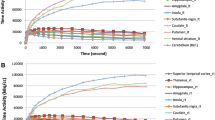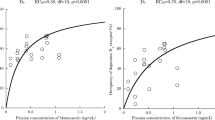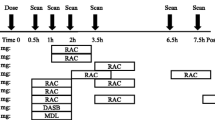Abstract.
Rationale: Previous work suggests clozapine preferentially targets limbic cortical dopamine systems, which could help account for its lack of extrapyramidal side effects (EPS) and superior therapeutic efficacy. Objectives: To test the hypothesis that olanzapine, a novel atypical antipsychotic drug, occupies temporal cortical D2/D3 receptors to a greater extent than striatal D2/D3 receptors in vivo. Methods: Nine schizophrenic patients taking either olanzapine [(n=5; mean (SD) age: 32.5 (6.5) years; daily dose: 18.3 (2.6) mg] or sertindole [(n=4; mean (SD) age: 30.3 (7.4) years; daily dose: 16 (5.6) mg] were studied with [123I]epidepride ((S)-N-[(1-ethyl-2-pyrrolidinyl)methyl]-5-iodo-2,3-dimethoxy-benzamide) and single photon emission tomography (SPET). An estimate of [123I]epidepride 'specific binding' to D2/D3 receptors was obtained in patients and age-matched healthy volunteers. A summary measure was generated representing striatal and temporal cortical relative %D2/D3 receptor occupancy by antipsychotic drugs. Occupancy data were compared with previously studied groups of patients receiving typical antipsychotic drugs (n=12) and clozapine (n=10). Results: Mean striatal and temporal cortical %D2/D3 receptor occupancy in olanzapine-treated patients was 41.3% (SD 17.9) and 82.8% (SD 4.2), respectively. Unexpectedly low levels of striatal relative %D2/D3 receptor occupancy were seen in two patients with typical antipsychotic-drug-induced movement disorder prior to switching to olanzapine. In the temporal cortex, mean D2/D3 dopamine receptor occupancy levels above 80% were seen for all antipsychotic drugs studied. Conclusions: The atypical antipsychotic drugs olanzapine and sertindole, in common with clozapine, demonstrate higher occupancy of temporal cortical than striatal D2/D3 dopamine receptors in vivo at clinically useful doses. This could help mediate their atypical clinical profile of therapeutic efficacy with few extrapyramidal side effects. Limbic selective blockade of D2/D3 dopamine receptors could be a common action of atypical antipsychotic drugs.
Similar content being viewed by others
Author information
Authors and Affiliations
Additional information
Electronic Publication
Rights and permissions
About this article
Cite this article
Bigliani, V., Mulligan, R., Acton, P. et al. Striatal and temporal cortical D2/D3 receptor occupancy by olanzapine and sertindole in vivo: a [123I]epidepride single photon emission tomography (SPET) study. Psychopharmacology 150, 132–140 (2000). https://doi.org/10.1007/s002130000435
Received:
Accepted:
Issue Date:
DOI: https://doi.org/10.1007/s002130000435




